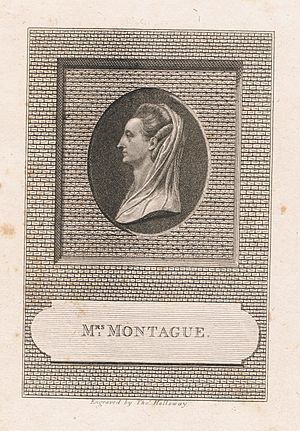Thomas Holloway (painter) facts for kids
Thomas Holloway (born in London in 1748 – died in Coltishall in 1827) was an English artist. He was known for painting portraits and for creating detailed engravings. Engraving is a method of carving designs onto a surface, often metal, to print images.
Holloway started learning his craft at a young age. He was an apprentice to a seal engraver named Stent. Later, in 1773, he began studying engraving at the Royal Academy. During this time, he also showed his pastel portraits at the Society of Artists. He lived in different places throughout his life, including Hampton and Coltishall in Norfolk. In 1792, he became a court engraver, meaning he worked for the royal family.
Contents
Life of Thomas Holloway
Thomas Holloway was born in Broad Street, London. He was the oldest son of a merchant. His father was an early follower of John Wesley, who founded Methodism. A famous painter named John Russell even painted a portrait of Thomas's mother.
Thomas was first apprenticed to a seal engraver named Stent. He mostly carved designs onto steel for his employer. Later, he attended the Royal Academy schools. In 1773, he first showed his engraved seals and gems at the Royal Academy. After that, until 1792, he also showed miniature paintings and portraits made with oils and crayons.
Holloway was a Baptist, a type of Christian. He never married. He passed away in Coltishall, near Norwich, on February 29, 1827. He was almost 80 years old.
Thomas Holloway's Artworks
Holloway mostly focused on line engraving. This is a technique where lines are cut into a metal plate to create an image. His first published works were small portraits for magazines. Many of these were of nonconformist ministers, who were religious leaders outside the main church.
Later, he worked on a large project. This was an edition of Essays on Physiognomy by Johann Kaspar Lavater. This book was about how a person's face might show their character. Holloway helped illustrate the book with about 800 plates. Other famous artists like William Blake also worked on this project.
His portraits included important people like Charles Howard, the Duke of Norfolk. He also engraved portraits of Timothy Priestley and Richard Price. Holloway also contributed illustrations to other famous books. These included John Boydell's Shakespeare and Robert Bowyer's History of England. He also worked on illustrations for Bell's British Theatre.
Engraving the Raphael Cartoons
One of Holloway's most famous and challenging projects was engraving the Raphael cartoons. These are large, famous drawings by the Italian Renaissance artist Raphael. They were located at Windsor Castle. Holloway started this huge task in 1800 and worked on it for 30 years. Even though it was a massive effort, it did not make him much money.
With help from artist Benjamin West, Holloway got permission to engrave these seven cartoons. He hired his former students, R. Slann and T. S. Webb, to help him. They also worked with another artist named Joseph Thomson. They worked together at Windsor until 1814. Then, the cartoons were moved to Hampton Court.
The first engraving, Paul preaching at Athens, was finished in 1806. The King then named Holloway his historical engraver. The second, Christ's Charge to Peter, was done in 1810. The third, The Death of Ananias, was completed in 1816. The fourth, Elymas, came out in 1820. By that year, all the initial drawings were ready. Holloway and his team moved to Edgefield and then Coltishall in Norfolk. They continued working on the plates there. The fifth plate, The Miraculous Draught of Fishes, was released in 1824. This was the last one Holloway finished before he died.
The sixth plate, Paul and Barnabas at Lystra, was almost done when Holloway passed away in 1827. The seventh, Peter and John at the Beautiful Gate, had just been started. The sixth plate was published in 1828. The last plate was finally finished in 1839. It was dedicated to the Queen. All the completed engravings showed the names of Holloway, Slann, and Webb as the artists.
Holloway's Family
Thomas Holloway created crayon portraits of himself and his nephew, who was a naval captain. His brother, John Holloway, was a popular lecturer. He talked about a topic called "animal magnetism," which was a belief about an invisible natural force. Thomas sometimes gave lectures to support his brother's ideas.




